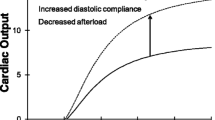Abstract
The ventricular elastance concept (instantaneous pressure-volume ratio) has been used extensively in characterising the ventricular mechanics of animal hearts. In the paper, this technique is extended to the characterisation of the ventricular mechanics of the normal and failing human heart. Techniques for the processing of catheterisation data are discussed and the results indicate the feasibility of using this simple method to assess routinely the ventricular mechanics of the human subject undergoing cardiac catheterisation.
Sommaire
On a fait un usage considérable du concept d'élastance ventriculaire (rapport instantané volume/pression) en ce qui concerne la caractérisation des mécanismes ventriculaires du coeur des animaux. Dans ce rapport, on a élargi cette technique à la caractérisation des mécanismes ventriculaires du coeur humain normal et du coeur défaillant. Des techniques pour le traitement des données de cathétérisation sont examinée et les résultats montrent qu'il est possible d'employer cette méthode simple pour établir d'une façon courante les mécanismes ventriculaires d'un être humain subissant une cathétérisation cardiaque.
Zusammenfassung
Der Begriff der Ventrikelelastanz (Verhältnis Momentandruck/Volumen) ist weitgehent für die Kennzeichnung der Vetrikelmechanik von Tierherzen verwendet worden. In diesem Beitrag wird das Verfahren auf die Kenzeichnung der Ventrikelmechanik des normalen und kranken menschlichen Herzens ausgedehnt. Es werden Verfahren für die Verarbeitung von Katheterisationsdaten besprochen und die Resultate deuten auf die Durchführbarkeit dieses einfachen Verfahrens zur routinemäßigen Bestimmung der Ventrikelmechanik eines menschlichen Patienten hin, der Herz-Katheterisation unterworfen wird.
Similar content being viewed by others
References
Braunwald, E. andSonnenblick, E. H. (1967)Mechanisms of contraction of the normal and failing heart, Little, Brown & Co., Boston Mass.
Dekker, D. L., Piziali, R. L. andDong, E. (1974) A system for ultrasonically imaging the human heart in three dimensions.Computers and biomedical research 7, 544–553.
Donders, J. J. H. andBeneken, J. E. W. (1971) Computer model of cardiac muscle mechanics.Circ. Res. 29, Suppl. 1, 34–50.
Gold, B. andRader, C. M. (1969)Digital proceessing of signals. McGraw-Hill, New York.
Greene, D., Carlisle, R., Grant, C. andBrunnell, I. (1967) Estimation of left ventricular volume by one-plane cineangiography.Circ. 35, 61.
Greene, M. E., Clark, J. W., Mohr, D. N. andBourland, H. M. (1973) A mathematical model of left ventricular function.Med. & Biol. Eng.,11, 125–134.
Greene, M. E. andClark, J. W. (1973) The innervated left ventricle: A mathematical model of ventricular function.Med. & Biol. Eng.,11, 464–468.
Greene, M. E. andClark, J. W. (1974) On modelling the function of sympathetic ventricular fibres.Med. & Biol. Eng. 12, 664–674.
Greene, M. E., Nudelman, H. B. andClark, J. W. (1975) The responses of the left ventricle to left sympathetic burst-like stimulation.Med. & Biol. Eng. (in press).
Greville, T. N. E. (1969) Introduction to spline functions. InTheory and application of spline functions. Academic Press, New York.
Hunt, B. R. (1970) The inverse problem of radiography.Math. Biomech.,8, 161–179.
Kasser, I. S. andKennedy, J. W. (1969) Measurement of left ventricular volumes in man by single plane cineangiocardiography.Invest. Radiol. 2, 83–90.
Kloster, F. E., Bristow, J. D., Porter, G. A., Judkins, M. P. andGriswold, H. E. (1967) Comparative hemodynamic effects of equiosmolar injections of angiographic contrast materials.Invest. Radiol. 2, 353–359.
Mason, D. T. et al., (1971) Comparison of the contractile state of the normal, hypertrophied and failing heart in man.Cardiac Hypertrophy, N. R. Alper, Ed., Academic Press, New York, 433–444.
Mirsky, I. (1969) Left ventricular stresses in the intact human heart.Biophys. J. 9, 189–208.
Noordergraaf, A. (1969)Hemodynamics in biological engineering, H. P. Schwan, Ed., Chap. 5.
Ross, J. Jun,et al. (1966) Contractile state of the heart characterised by force-velocity relations in variably afterloaded and isovolumic beats.Circ. Res. 48, 149–163.
Sandler, H. andDodge, H. T. (1963) Left ventricular tension and stress in man.Circ. Res. 13, 91–104.
Sandler, H. andDodge, H. T. (1968) The use of single plane angiocardiograms for the calculation of left ventricular volume in man.Amer. Heart. J. 75, 325–334.
Schultz, M. H. (1973)Spline analysis, Prentice-Hall Inc., Englewood Cliffs, NY.
Sonnenblick, E. H. (1969) The mechanics of myocardial contraction, inThe myocardial cell, S. A. Briller and H. L. Conn, Jun. (Eds.), University of Pennsylvania, Press, Philadelphia, Pa., 173–250.
Streeter, D. D.,et al. (1970) Stress distribution in the canine left ventricle during diastole and systole.Biophys. J. 10, 345–363.
Suga, H. (1969) Time course of left ventricular pressure-volume relationship under various end-diastolic volumes.Japan Heart J.,10, 509–515.
Suga, H. (1971) Left-ventricular time-varying pressure-volume ratio in systole as an index of myocardial inotropism.Japan. Heart J. 12, 153–160.
Suga, H. (1972) Theoretical analysis of a left ventricular pumping model based on the systolic time-varying pressure-volume ratio.IEEE Trans. BME-18, 47–55.
Suga, H. andSugawa, K. (1972) Mathematical interelationship between instantaneous ventricular pressure volume ratio and myocardial force-veocity relation.Annals of Biomed. Eng.,1, 160–181.
Suga, H., Sagawa, K. andShoukas, A. A. (1973) Load impedance of the instantaneous pressure-volume ratio of the canine left ventricle and effects of epinephrine on the ratio.Circ. Res. 32, 314–322.
Wong, A. Y. K. (1968) Stress distribution within the left ventricular wall approximated as a thick ellipsoidal shell.Amer. Heart J. 75, 649–662.
Yanof, H. M. (1965) Introduction to biomedical instruments, InBiomedical electronics, Chap. 11.
Author information
Authors and Affiliations
Rights and permissions
About this article
Cite this article
Clark, J.W., Pruett, R.C., Baldridge, D.L. et al. Functional model for the characterisation of the ventricular mechanics of the human subject. Med. Biol. Eng. Comput. 15, 335–348 (1977). https://doi.org/10.1007/BF02457985
Received:
Accepted:
Issue Date:
DOI: https://doi.org/10.1007/BF02457985




